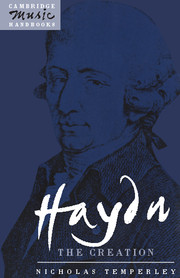Book contents
5 - Design of the work
Published online by Cambridge University Press: 05 June 2012
Summary
Overall plan
The Creation is blessed with one of the strongest and most logical large-scale structures in eighteenth-century vocal music. No setting of the Mass can equal it in this respect, because the shape of the Mass Ordinary is intractably lopsided: this often created problems in a period when balance and symmetry were basic aesthetic assumptions. The St Matthew Passion, Saul and Messiah had structures as sturdy as The Creation's; among the masterpieces of the classical period perhaps only Così fan tutte is its equal in this respect.
Strength of design was the best feature of the original English libretto, and fortunately it was not fatally weakened by van Swieten's cuts and alterations. So Haydn was able to develop his symphonic and operatic gifts, together with his more recently acquired understanding of Handelian choral writing, within a framework that balanced all these elements and showed them to their best advantage.
The oratorio falls into three parts, the first two roughly equal in length and the third somewhat shorter. Each part is clearly subdivided into groups of movements ending with a triumphant chorus. There are seven such groups in all, as shown in Table 1. Thus, as the angels narrate and comment on the successive wonders of the natural world, and then (in Part Three) Adam and Eve gaze on the new world and find each other's love, each development is crowned by a choral movement that brings together all the available forces and raises to new heights the uplifting effect of the preceding group of movements.
- Type
- Chapter
- Information
- Haydn: The Creation , pp. 47 - 64Publisher: Cambridge University PressPrint publication year: 1991

